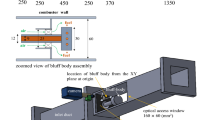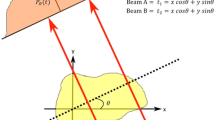Abstract
This paper describes applications of computed tomography (CT) to combustion phenomena under microgravity conditions. Infrared Thermography (IT) has been considered as a promising method for two-dimensional measurement of flames. We have applied IT to CT for a butane flame under microgravity conditions. The method joining spectroscopy to CT for diffusion flame of hydrogen has also been carried out. Intensity of chemical luminescence, which is originated from combustion-chemical reaction in the flame, can be measured by scanning a spectrometer with collimator. The effectiveness of the CT applications to microgravity combustion has been confirmed from two method.
Similar content being viewed by others
References
Kak, A. C., Jakowatz, C. V., Baily, N. A. and Keller, R. A., Computerized Tomography Using Video Recorded Fluoroscopic Images, IEEE Transactions on Biomedical Engineering, BMF-24-2 (1977), 157–177.
Kumagai, S. and Isoda, H., Combustion of Fuel Droplets in a Falling Chamber, Sixth Symposium (International) on Combustion (New York), (1957), 726–731.
Shepp, L. A. and Logan, B. F., The Fourier Reconstruction of a Head Section, IEEE Transactions on Nuclear Science, NS-21 (1974), 21–43.
Shimizu, M., Itoh, K., Hayashi, S., Fujimori, Y., Morita, T. and Sato, J., Basic Research on Microgravity Combustion in the Frontiers Joint Research, Proceedings of Third China-Japan Workshop on Microgravity Science (Beijing), (1996), 206–211.
Author information
Authors and Affiliations
Additional information
Hitoshi Sato: He received his Ph.D. degree in mechanical engineering from Chiba University in 1996. After working the Institute of Physical and Chemical Research (RIKEN), he joined the Space Project and Research Center, National Aerospace Laboratory (NAL) on October, 1996, as the Domestic Research Fellow of Japan Science and Technology Corporation to September, 1999, and as the contract researcher of Japan Space Forum from October 1999. His current research interests include solar thermal propulsion, microgravity combustion, CT technique, laser cavitation and laser-matter interaction.
Katsuya Itoh: He joined the Space Technology Research Group of the National Aerospace Laboratory (NAL) in 1964, where he researched solid rocket reliability technique, microgravity combustion. He is the senior researcher of the Space Project and Research Center, NAL. His research interests in solar thermal propulsion.
Morio Shimizu: He received his MS degree of mechanical engineering in 1967 from Tohoku University. In 1967, he joined the First Aerodynamic Division of the National Aerospace Laboratory (NAL), and in 1969 moved to the Space Technology Research Group, NAL, where he researched solid rocket reliability technique and microgravity combustion. He took his Doctor of engineering in ultrasonic inspection of solid rocket motors from the University of Tokyo in 1990. He is the Leader of the Space Energy Utilization Research Group, Space Project and Research Center, NAL. His current area of interest is the solar thermal propulsion. He researches at present as the Visiting Scholar at the Propulsion Research Center, University of Alabama in Huntsville (UAH).
Shigeru Hayashi: He received his Doctor of Engineering in 1976 from Graduate School of Aeronautics, University of Tokyo. He joined Aircraft Emissions Research Group, the National Aerospace Laboratory 1997. Since then he has been doing researches related to low emissions combustion for aeropropulsion and industrial gas turbines, and laser diagnostics of sprays. He is now Leader for Low-NOx Emissions Research Group at the NAL Aeropropulsion Center.
Yoshinori Fujimori: Bachelor of Engineering from the University of Tokyo, Ph.D. and MS from University of Illinois in Aeronautical and Astronautical Engineering. Research scientist in National Aerospace Laboratory Tokyo (NAL) majoring in Stochastic Structural Dynamics. A number of publications in the AIAA Journal and relevant Japanese technical journals. Manager and program coordinator of National Space Development Agency of Japan (NASDA) in all aspect of space environment utilization. Received Distinguished Service Award and Distinguished Service Medal from Japan Society of Mechanical Engineers (JSME) at Centennial, Associate Fellow of AIAA, Member of JSME, Japan Society of Aeronautical and Astronautical Sciences, Japan Rocket Society, and Japan Society of Microgravity Applications.
Kazuo Maeno: He received his BSc(Eng.) degree in aeronautics in 1974 from Faculty of Engineering, the University of Tokyo, and his Master and Doctor of Engineering in aerospace engineering in 1976 and 1979 from the University of Tokyo. After taking the Doctor, he started his research career as a research associate at Tokyo Metropolitan College of Aeronautical Engineering. In 1981 he moved to Muroran Institute of Technology as an associate professor, then from 1990 he has worked as an associate professor at Chiba University. During the current position, he was an invited researcher of CNRS-Marseille (University of Marseille II) in 1993. His research interests covers shock waves, supersonic and hypersonic gasdynamics, cavitation and multiphase fluid dynamics in cryogenic range, high power fast-flow gas lasers and laser applications, pressure wave problems in high-speed railway tunnel, and multi-dimensional flow field visualization.
Rights and permissions
About this article
Cite this article
Sato, H., Itoh, K., Shimizu, M. et al. Application of computed tomography to microgravity combustion. J Vis 2, 353–358 (2000). https://doi.org/10.1007/BF03181450
Received:
Revised:
Issue Date:
DOI: https://doi.org/10.1007/BF03181450




